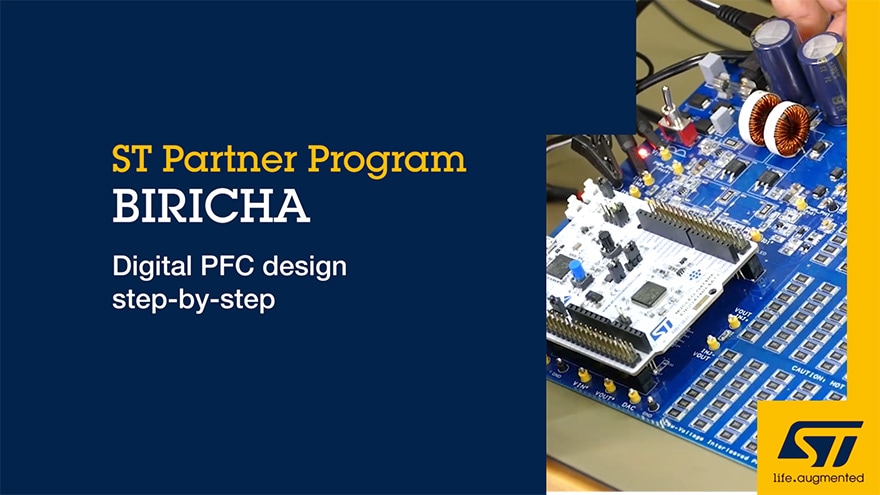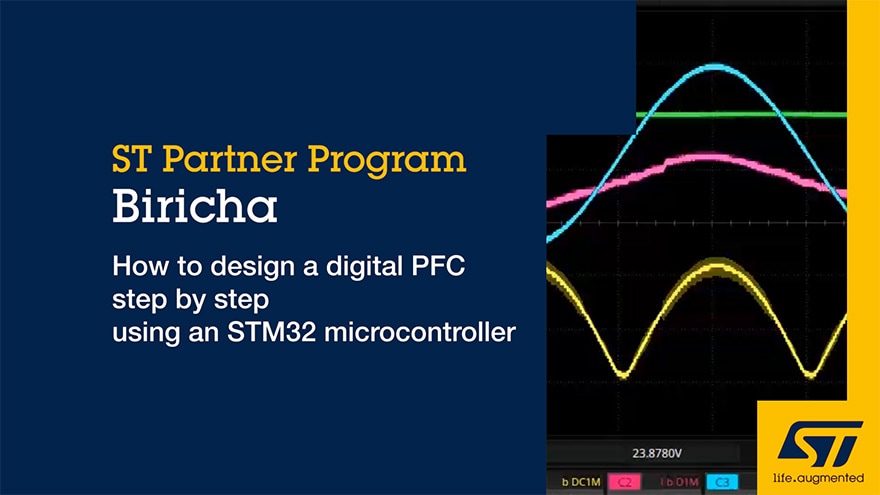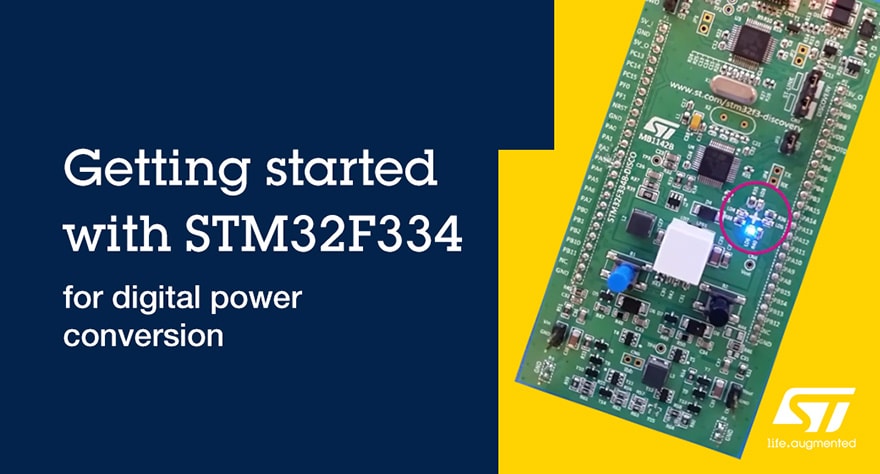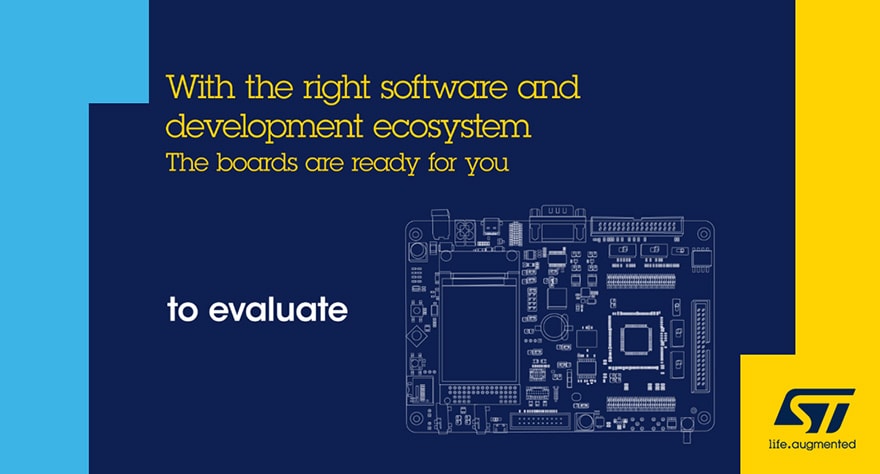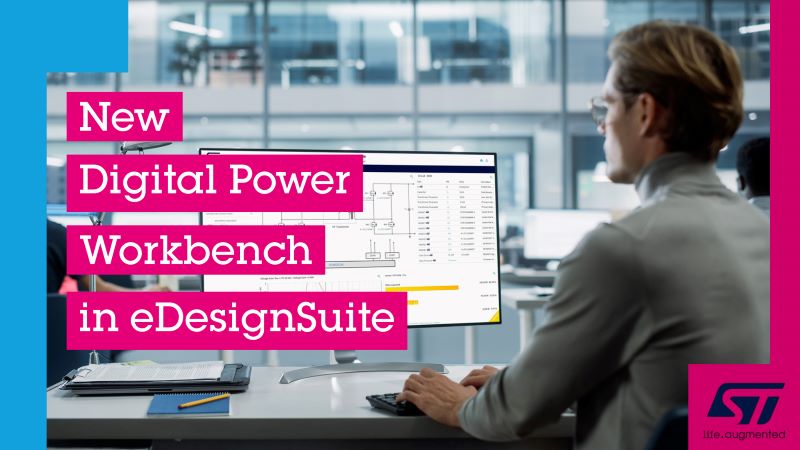
STM32 Digital Power Ecosystem
The STM32 Digital Power ecosystem (D-Power) helps developers accelerate the development of digital power applications, such as digital SMPS, lighting, welding, inverters for solar systems, and wireless chargers. It offers hardware, software tools, embedded software, training resources, and documentation.
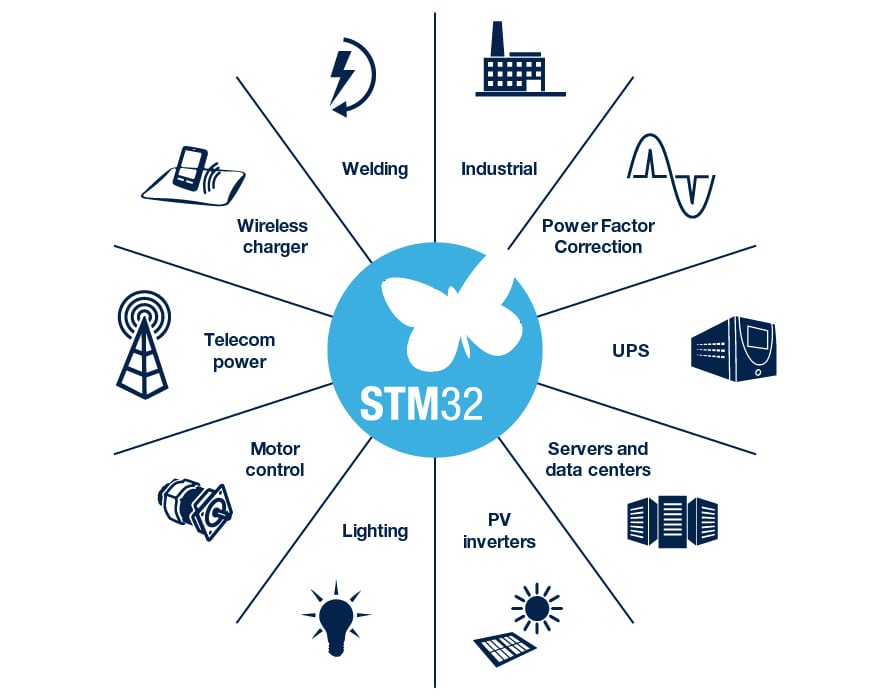
STM32 D-Power product lines
The STM32F3, STM32G4, and high-performance STM32H7 MCU series come with a set of features that enable digital power designs.
The STM32F334, STM32G4x4, STM32H74x and STM32H75x MCU lines offer an embedded high-resolution timer (HRTimer), a powerful and flexible pulse width modulation (PWM) generator providing a resolution down to 184ps.
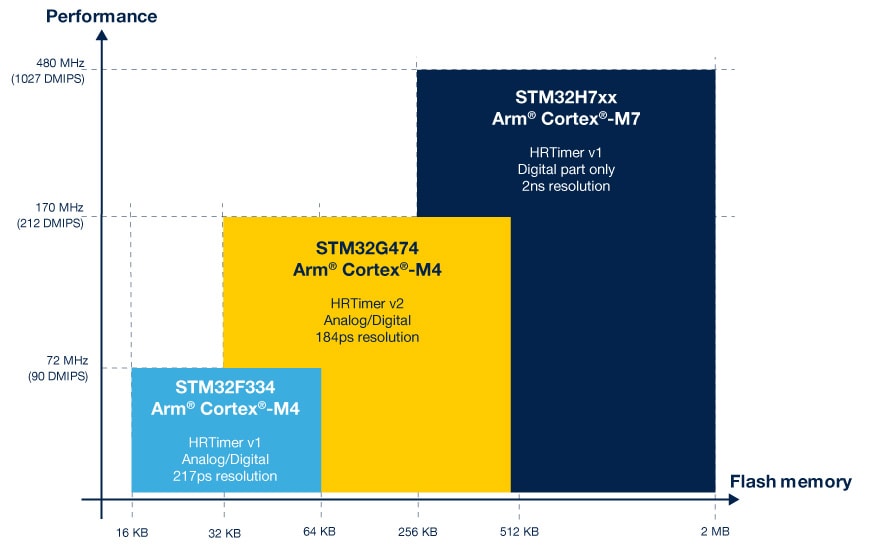
The embedded HRTimer offers high resolution and includes a waveform builder & event handler:
High resolution
- 184ps (with STM32G474) or 217ps (with STM32F334)
- up to 12 channel timer made of units that can either be cross-coupled or work independently
- high resolution on all channels at all times regardless of voltage, temperature or manufacturing deviation
Waveform Builder & Event Handler
- Advanced PWM waveform generation with minimal software use
- smart functions, such as a hardware burst-mode controller, auto delayed mode, external events windowing, delayed and re-enabled balance idle , slope compensation, valley skipping, protection schemes
- one DMA channel per timer
- one parameter modification can change multiple events (timer chaining)
- Complex event management
- 12 or 10 external event inputs and up to 6 fault inputs
- Numerous interconnect
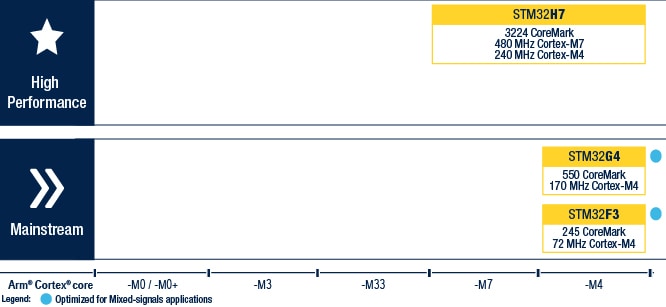
STM32 D-Power as an evolutive ecosystem
The STM32 D-Power ecosystem addresses the requirements of beginner- to expert-level developers in the field of digital power.
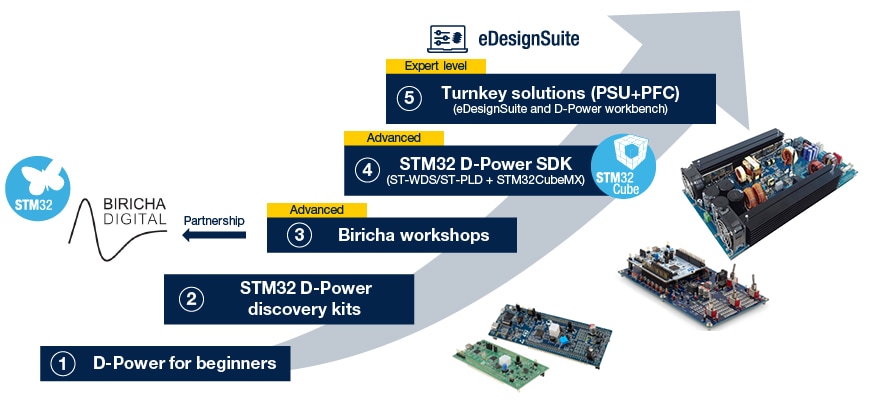
Step 1 - Digital power for beginners
Understand the basics of digital power with these 2 videos:
Increase your level of knowledge on digital power by watching these webinar recordings:
Step 2 - Digital power discovery kits
| Hardware | Photo | Description | Application Notes |
| STM32G474 discovery kit | 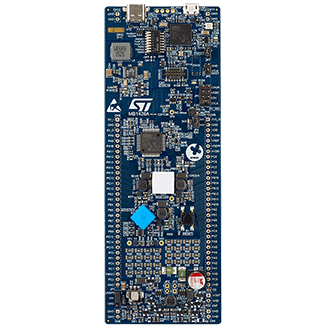 | The B-G474E-DPOW1 Discovery kit is a digital power solution and a complete demonstration and development platform based on the STM32G474RET6 microcontroller, leveraging the performance of the HRTimer. | AN4539: High resolution timer cookbook programming |
| STM32F334 discovery kit |  | Explore the features of the STM32F334 line of MCUs with the F3348DISCOVERY kit and build your digital power application. | AN4449: Buck-boost converter |
Step 3 - Hands-on workshops to take your project to the next level
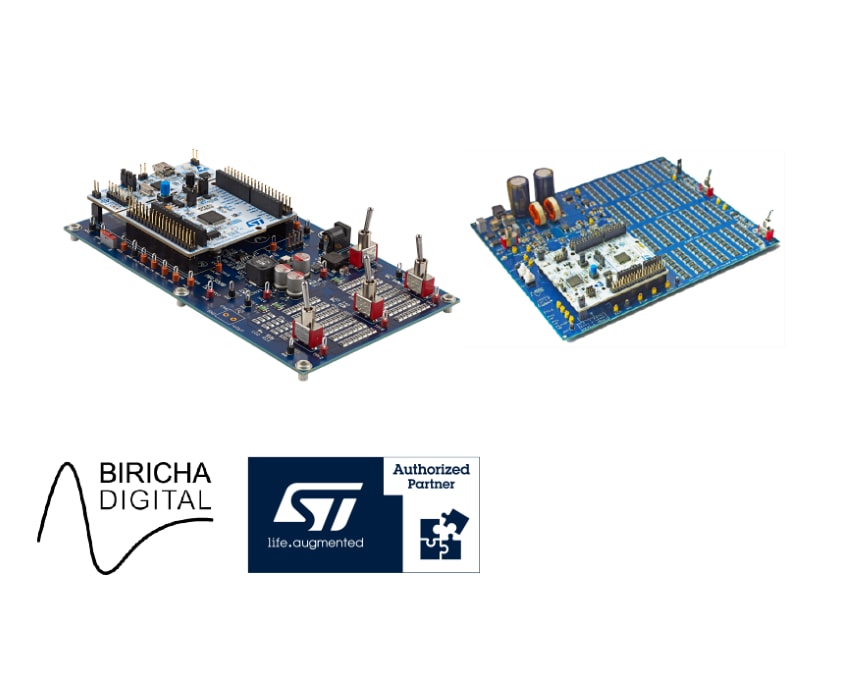
Digital power supply and PFC design workshops with STM32
ST teams up with Biricha to offer expert-level training on designing digital power applications based on the STM32 development ecosystem.
Learn how to design, code, implement and test stable digital power supply for both voltage and current mode DC/DC and digital power factor correction (PFC) applications, addressing the most recent industry needs.
Step 4 - PSU and PFC software development kit
Discover our set of PC software tools and embedded software examples to develop digital solutions for PSU and PFC.
Our Authorized Partner Biricha developed two user-friendly software tools, compatible with STM32Cube, to help you compute all the digital closed-loop coefficients, to match topologies, and quickly stabilize their PSU and PFC design.
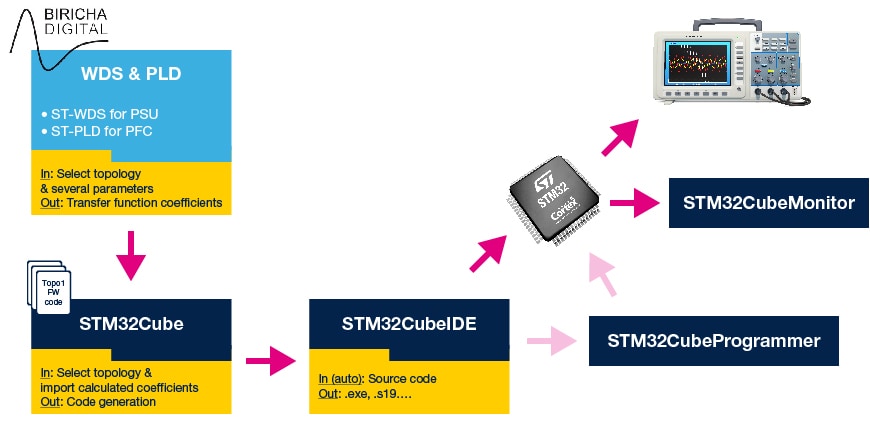
Available in STM32CubeMX,the X-CUBE-DPOWER software package contains embedded software examples (buck/current mode and buck/voltage mode), which can run on the B-G474E-DPOW1 and 32F3348DISCOVERY discovery kits.
- The following topologies are available:
- interleaved boost PFC converter in average current control mode
- phase-shifted full-bridge DCDC with constant voltage/current output
- buck and boost PSU converters in Voltage and Current control mode
- Control loop based on PID or on Pole and Zero (2P2Z, 3P3Z) compensator
- advanced control loop for better performance and stability
- digital implementation of type III controller
- coefficients generated using ST-WDS/ST-PLD tools from Biricha Digital (free version for STM32 users)
Discover useful tools and resources to move forward with your design journey:
| Resource | Description |
| X-CUBE-DPOWER | Expansion package for generating a startup project file directly from the STM32CubeMX GUI and initializing the library according to the application. |
| STM32CubeG4 | HAL, Low-Layer APIs, and CMSIS, USB, File system, RTOS, graphics and examples running on ST boards for the STM32G4 MCU series. |
| STM32 Digital Power Workbench | This design tool simplifies the design of complex power converters. Users can evaluate, analyze, and customize several topologies with full digital control using the STM32G4 MCU. |
| STM32CubeMX | STM32CubeMX enables hardware engineers, embedded software developers, and R&D teams across all industries to handle their projects with ease. |
| STM32CubeIDE | STM32CubeIDE allows faster application deployment by easing all tasks of the software development cycle. |
| STM32CubeProgrammer | All-in-one multi-OS software tool for programming STM32 products. It provides user-friendly environment for reading, writing, and verifying device memory through both the debug interface (JTAG and SWD) and the bootloader interface (UART, USB DFU, I2C, SPI, and CAN). |
| STM32CubeMonitor | The STM32CubeMonitor tools help users evaluate the performance of STM32 applications at runtime by enabling data visualization in real time. |
| Digital Power Brochure | Learn more about the typical digital power management architecture, and the building blocks required for digital power designs. |
Step 5 – Turnkey solutions
ST tools, development boards, and reference designs are there to help you take your digital design for PSU and PFC applications to the next level.
Digital Power Workbench – now available in eDesignSuite
Evaluate, analyze and customize the designs of several topologies with full digital control using the STM32G4 microcontroller.
- Supported topologies (AC/DC, DC/DC)
- ZVS Interleaved Totem-Pole, Vienna Rectifier, 3-Level t-type converter
- FB LLC
| Hardware | Photo | Power | Output Voltage | PFC | DC-DC | Comment | ||
| Topology | Control model (PID or Type 2) | Topology | Control model (PID or Type 2) | |||||
| STEVAL-ISA172V2 |  | 2 kW | 48 V | 2-Channel Interleaved CCM Boost | PID | ZVS Phase Shift FB with SR | PID | |
| STEVAL-DPSLLCK1 |  | 3 kW | 48 V | N.A. | N.A. | FB LCC with SR | PID | DC-DC Converter |
| STEVAL-ISA147V3 |  | 500 W | 12 V | Dual-Boost Semi-bridgeless | PID | HB LCC with SR | PID | PFC based on STM32F051 |
| STEVAL-DPSTPFC1 |  | 3.6 kW | 400 V | Totem-pole Bridgeless | PID | N.A. | N.A. | PFC converter |
| STEVAL-LLL009V1 |  | 300 W | 48 V | TM Boost | Analog Control | HB LCC with SR | PID | CC and CV operation |
| STDES-PFCBIDIR |  | 15 kW | DC voltage: 800 VDC AC Voltage 400 VAC @ 50 Hz | Topology: 3-phase, 3-level bidirectional AC/DC, DC/AC power converter | PID | N.A. | N.A. | STDES reference design is not for sale, documentation is available to support the development of prototypes |
Embedded software examples implement the “standard PID model” and can be used as jump-starters on these topologies. They will soon be updated to match the models supported by Biricha’s PC software tools in order to improve stability and performance.

